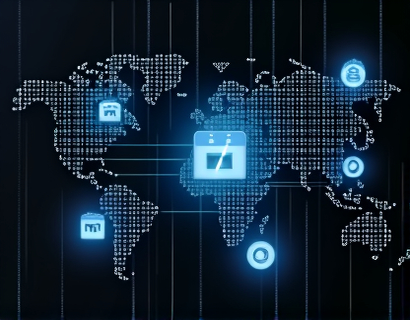Agricultural Software: Transforming Farming Efficiency with Customized Tech Solutions
In the rapidly evolving landscape of agriculture, the integration of advanced technology has become pivotal for enhancing efficiency and productivity. Agricultural software, often referred to as AgriTech, plays a crucial role in revolutionizing farming operations. These sophisticated tools are designed to streamline processes, optimize resource utilization, and support strategic decision-making, ultimately driving the success of farming businesses and professionals.
The adoption of agricultural software solutions is no longer a luxury but a necessity in modern farming. With the global population projected to reach 9.7 billion by 2050, the demand for food is increasing exponentially. To meet this demand, farmers must adopt innovative methods and technologies that can significantly boost their output while minimizing costs and environmental impact. AgriTech provides the necessary tools to achieve these goals, making it an essential component of contemporary agricultural practices.
Streamlining Farming Processes
One of the primary benefits of agricultural software is its ability to streamline various farming processes. From planting and harvesting to livestock management and supply chain logistics, these tools automate and simplify tasks that were once time-consuming and error-prone. For instance, precision agriculture software uses GPS and sensor technology to monitor and manage crop health, soil conditions, and irrigation systems. This level of precision ensures that resources such as water and fertilizers are used efficiently, reducing waste and increasing yields.
Another area where software significantly improves efficiency is in the management of farm equipment. Fleet management systems allow farmers to track the location, usage, and maintenance needs of their machinery. This real-time data helps in scheduling timely repairs and optimizing the use of equipment, thereby reducing downtime and maintenance costs. Additionally, these systems can predict equipment failures before they occur, allowing for proactive maintenance and further enhancing operational efficiency.
Enhancing Data Management
Data is the backbone of modern agriculture, and effective data management is crucial for informed decision-making. Agricultural software solutions provide robust platforms for collecting, storing, and analyzing vast amounts of data. This data can include historical crop yields, weather patterns, market trends, and more. By centralizing this information, farmers and agricultural professionals can gain valuable insights that were previously difficult to obtain.
For example, data analytics tools can process historical yield data to identify patterns and trends, helping farmers make better planting decisions. Similarly, weather forecasting integrated with farm data can alert farmers to potential weather-related risks, enabling them to take preventive measures. This data-driven approach not only improves decision-making but also enhances overall farm productivity and profitability.
Supporting Strategic Decision-Making
Strategic decision-making is essential for the long-term success of any farming operation. Agricultural software empowers farmers and agricultural professionals to make informed decisions by providing actionable insights and predictive analytics. Decision support systems (DSS) are a key component of this, offering tools that help in evaluating different scenarios and their potential outcomes.
For instance, a DSS can simulate the impact of various farming practices on crop yields, taking into account factors such as soil type, climate, and market prices. This capability allows farmers to experiment with different strategies virtually, reducing the risks associated with trial-and-error approaches. Moreover, these systems can integrate with financial management tools to assess the economic viability of different options, ensuring that decisions are both strategically sound and financially viable.
Improving Resource Management
Efficient resource management is critical for sustainable farming. Agricultural software helps in optimizing the use of resources such as water, fertilizers, and pesticides. By monitoring soil moisture levels and plant health, irrigation management systems can determine the exact amount of water needed, preventing over-irrigation and conserving this vital resource. Similarly, precision application systems for fertilizers and pesticides ensure that these chemicals are used only where needed, reducing environmental impact and lowering costs.
Furthermore, inventory management software helps farmers keep track of inputs and outputs, ensuring that resources are used efficiently and waste is minimized. This level of control not only enhances productivity but also contributes to more sustainable farming practices, aligning with global efforts to promote environmentally friendly agriculture.
Enhancing Market Access and Sales
Beyond farm operations, agricultural software also plays a significant role in improving market access and sales. E-commerce platforms and market analytics tools enable farmers to connect directly with consumers and distributors, expanding their market reach. These platforms provide real-time data on market prices, demand, and consumer preferences, allowing farmers to adjust their production and sales strategies accordingly.
Additionally, blockchain technology integrated into agricultural software can enhance transparency and traceability in the supply chain. By recording every step of the production and distribution process, farmers can build trust with consumers and meet the growing demand for ethically sourced and sustainably produced food. This increased transparency can lead to higher prices and better market positions for farmers.
Challenges and Considerations
While the benefits of agricultural software are undeniable, there are several challenges and considerations that farmers and agricultural professionals must address. One of the primary concerns is the initial cost of implementing these technologies. High upfront investments can be a barrier for small-scale farmers. However, the long-term benefits in terms of increased efficiency and productivity often justify the expense.
Another challenge is the need for technical expertise to effectively use and maintain these systems. Training and support are essential to ensure that farmers can fully leverage the capabilities of agricultural software. Many software providers offer training programs and customer support to help users get the most out of their tools.
Data security and privacy are also critical considerations. With the increased reliance on digital platforms, protecting sensitive farm data from cyber threats is paramount. Agricultural software providers must implement robust security measures to safeguard user information and maintain trust.
Future Trends in Agricultural Software
The future of agricultural software is promising, with several emerging trends set to further transform the industry. One such trend is the integration of artificial intelligence (AI) and machine learning (ML) into farming operations. AI-powered systems can analyze complex data sets to provide more accurate predictions and recommendations, enhancing decision-making and operational efficiency.
Another exciting development is the use of drones and autonomous vehicles in agriculture. Drones equipped with cameras and sensors can monitor crop health, detect pests, and assess soil conditions from the air, providing detailed insights that were previously difficult to obtain. Autonomous tractors and harvesting machines can operate with minimal human intervention, increasing efficiency and reducing labor costs.
Furthermore, the Internet of Things (IoT) is playing an increasingly important role in agricultural software. IoT devices can connect various farm equipment and sensors, creating a network of interconnected devices that share data in real-time. This interconnectedness enables more precise and coordinated farming operations, further optimizing resource use and improving yields.
Conclusion
Agricultural software is revolutionizing the way farming operations are conducted, offering numerous benefits that enhance efficiency, productivity, and sustainability. By streamlining processes, improving data management, supporting strategic decision-making, and optimizing resource use, these technologies are essential tools for modern farmers and agricultural professionals. As the industry continues to evolve, the integration of advanced technologies such as AI, drones, and IoT will further drive innovation and growth in agriculture. Embracing these solutions is not just an option but a necessity for those looking to thrive in the competitive and dynamic world of farming.










































